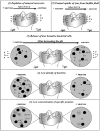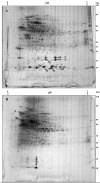The role of sucrose in cariogenic dental biofilm formation--new insight
- PMID: 16998125
- PMCID: PMC2257872
- DOI: 10.1177/154405910608501002
The role of sucrose in cariogenic dental biofilm formation--new insight
Abstract
Dental caries is a biofilm-dependent oral disease, and fermentable dietary carbohydrates are the key environmental factors involved in its initiation and development. However, among the carbohydrates, sucrose is considered the most cariogenic, because, in addition to being fermented by oral bacteria, it is a substrate for the synthesis of extracellular (EPS) and intracellular (IPS) polysaccharides. Therefore, while the low pH environment triggers the shift of the resident plaque microflora to a more cariogenic one, EPS promote changes in the composition of the biofilms' matrix. Furthermore, it has recently been shown that the biofilm formed in the presence of sucrose presents low concentrations of Ca, P(i), and F, which are critical ions involved in de- and remineralization of enamel and dentin in the oral environment. Thus, the aim of this review is to explore the broad role of sucrose in the cariogenicity of biofilms, and to present a new insight into its influence on the pathogenesis of dental caries.
Figures



References
-
- Aires CP, Tabchoury CP, Del Bel Cury AA, Koo H, Cury JA. Effect of sucrose concentration on dental biofilm formed in situ and on enamel demineralization. Caries Res. 2006;40:28–32. - PubMed
-
- Ashley FP, Wilson RF. Dental plaque and caries: a 3-year longitudinal study in children. Br Dent J. 1977;142:85–91. - PubMed
-
- Bennick A. Structural and genetic aspects of proline-rich proteins. J Dent Res. 1987;66:457–461. - PubMed
-
- Birkhed D, Frostell G, Lamm CJ. Cariogenicity of glucose, sucrose and amylopectin in rats and hamsters infected and noninfected with Streptococcus mutans. Caries Res. 1980;14:441–447. - PubMed
-
- Bowen WH. Do we need to be concerned about dental caries in the coming millennium? Crit Rev Oral Biol Med. 2002;13:126–131. - PubMed
Publication types
MeSH terms
Substances
Grants and funding
LinkOut - more resources
Full Text Sources
Other Literature Sources
Medical
Research Materials
Miscellaneous

